1978 brought many a fanzine into our viewing plane, this column we cover Fandomonium!

Fandomonium 1, 1978
Editor and publisher: Russell Allen Stamets

There were many fanzines published in the seventies, most being critiques of the popular comics of the time, as well as a training ground for those writers and artists who wanted to become professionals in the fields of comics and fantasy. Toward the tail end of that decade, Fandomonium was published by one Russell Allen Stamets. Most likely he was, like many, a high school or college student who wanted to show his love for the medium of comics, bring together others of a like mind, and maybe serve his ego a teeny tiny bit. It is mentioned that his father helped in the publishing, another commonality of young go-getters like Bill G. Wilson of The Collector, and many others. On to the contents!
Above you see the reason I probably bought this fanzine in the first place. I had seen Willie Blyberg’s Gil Kane-like work in other fanzines, such as his own Woweekazowie (already reviewed), and liked his polished pin ups and all too infrequent strips. Blyberg also contributed the inside back cover, seen below, with some help from another fan publisher, William Mutschler (of Entropy Cosmix).
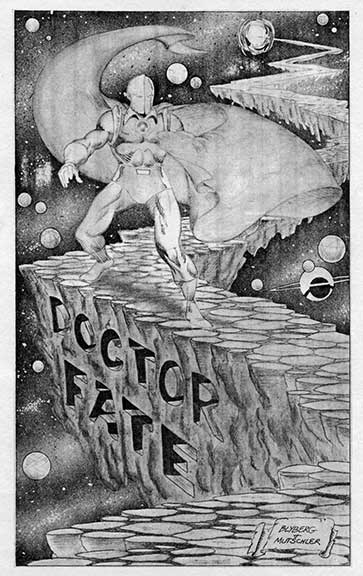
There are several other artists in this fanzine that had been and would be published in many other zines, including Willie Peppers, John Beatty, Fred Hembeck, and Earl Geier. Geier also had his own fanzine, Bald Ego, which showcased his wonderful sense of composition and layouts. Below you can see a few of his entries in Fandomonium.
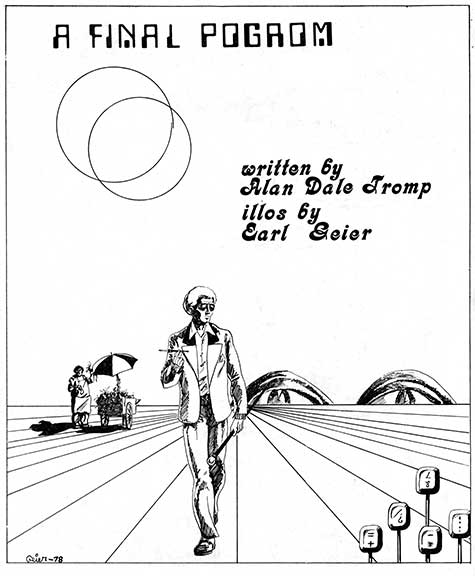
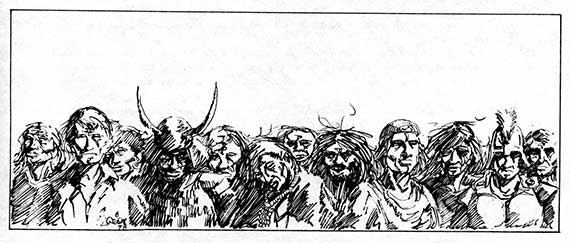
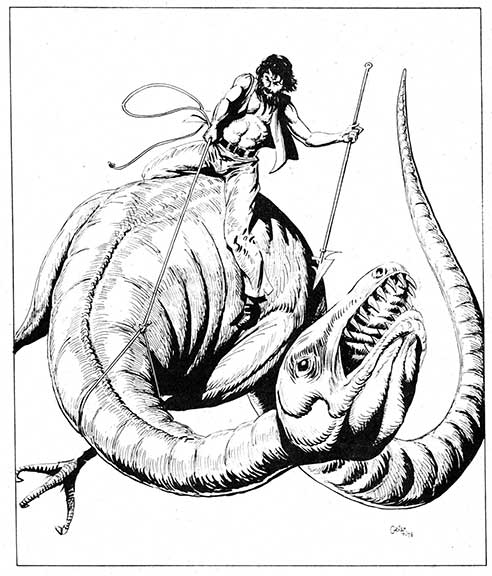
The first two illustrations were done to accompany a story by Alan Tromp called The Final Pogrom. The last fills the back cover space. I urge you to seek out Geier’s Bald Ego (or my coverage of it here in Ink Stains); he has written and drawn some really good stories. No elaborate feathering, no steroid enhanced superheroes, just good solid stories.
There are several other features you can see if you download the pdf of the whole fanzine, including a portfolio by artist Darwin Howe, a story called Age of the Sphere by Stephen R. Bullock, and a fanzine review column. You will also see illustrations by the artists mentioned, as well as Alan Hanley and John Beatty. What I am going to focus on for the remainder of the column, however, is a strip by one of the most prolific and hard working artists of fandom at that point, Willie Peppers. Willie Peppers has been in many fanzines (and later, professional publications), including many published by Steve Streeter of Paige Comics, such as Fandom Spectacular, which I covered in an earlier installment. I talked to Willie on Facebook, which you will see right after his story shown below.

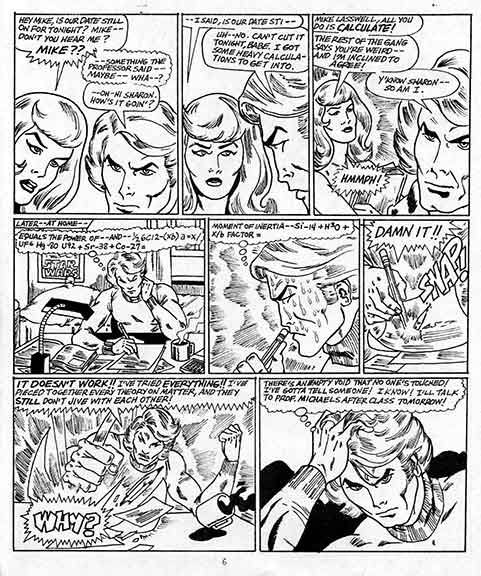



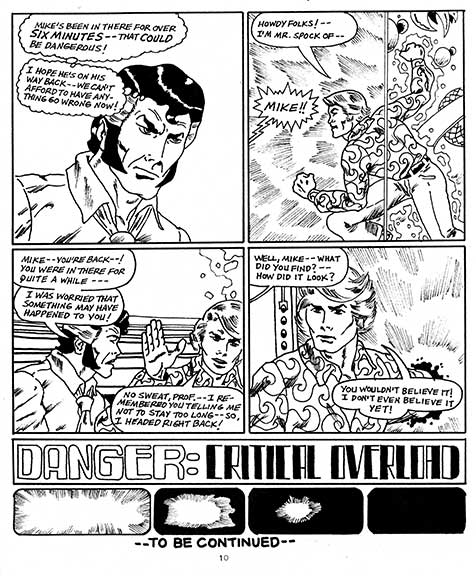
You can see Willie’s love of comics and his exuberance on every page, as well as probably a bit of a John Buscema influence! Below is the conversation I had with Willie about those days, as well as what he is up to now.
Ken: I am assuming comics started you drawing. If this is true, how old were you when you started?Willie: At age 5, I knew comics was what I wanted to do. I can still remember the first comic character I ever drew; Adam Strange.K: What was the actual physical process you started with; carbon paper, just looking at the comics and copying?W: I was never very good at copying. What I would do is get inspired by comics to create my own story lines. Sort of like What If. In the beginning, I would lie on the floor and draw on opened-up paper bags. Those were the days.
K: Ah, great! do you remember any comic titles that really really made you want to do comics?W: Way back in the beginning, I was strictly a Kirby fan. Still am. I later started to really appreciate some of the other greats like John Buscema, John Romita, Sr., Neal Adams, Jim Aparo, and a few others. I think, if I had to pick a single title I was most influenced by, it would be Lee and Kirby’s Fantastic Four.K: That is interesting to me in that your surface style seems to owe more to someone like John Buscema.W: True. He most heavily influenced my natural style in those days, but I learned to mimic Kirby.K: At what age (and maybe about what year, if you can remember it) did you learn of fandom?W: That would’ve been somewhere around the early 70s. I guess what really did it for me was discovering The Buyer’s Guide for Comic Fandom. That opened up a whole world for me.K: Ahhh, yeah, me too…the librarian at my high school gave me a copy (issue 8), and it opened up a whole new world. Do you remember the first fanzine you had work published in?W: I’m not absolutely certain, but I think my first fanzine work was for Steve Streeter’s Paige Comics.K: Ahhh…another commonality. He is here on Facebook, do you communicate with him often?W: I try to stay in touch. I guess maybe once a week or so. A lot of us had a lot of history with him. I don’t know if he knows it or not, but he was a springboard for a few careers.K: Yes, you are right…I am trying to think of others…Mark Heike maybe? Anyone else you can think of?W: I’m thinking Bill Reinhold did some stuff for Paige. Not sure.K: So, to go back to an earlier question, are there any specific jobs you would consider highlights of your fan career?W: Definitely my first paying gig, which was doing Southern Knights for David Anthony Kraft. Another one I was particularly proud of was my Malibu Comics work.I guess every project had its own singular appeal, but those are the ones that really stood out for me. Can’t leave out the Stormquest stuff for Sky Comics.K: Any projects from the fanzine days that stand out?W: More than anything, I would say the Paige comics stuff would take the lead. That experience let me know what it felt like to have my work seen by people other than family. For all intents and purposes, it let me know what it felt like to be an actual comics artist (although on a small scale).K: Your output always seemed so far beyond other fan artists. What do you think your page rate was like in the fandom/Paige days?W: Back then I could turn out maybe 4 or 5 pages a day. I also liked to pull all-nighters to get the job done. I still pull all-nighters, but I can’t match that output anymore.K: Yeah, I can see why you idolized Kirby!W: The King.K: I think you were probably one of the very few fan artists who had that kind of work ethic.W: It was what I wanted to carry over into a professional career. Nothing else was as important.K: What is your primary source of work nowadays?W: I’m a Graphic Designer/Typesetter for a publishing company here in Louisville, KY. Not only do I typeset and design the interior layout, I also design book covers (everything from novels, to textbooks, to genealogies).K: Are you doing any sequential work?W: I’m still doing comics as a freelancer. Still looking to make it my only profession.K: So, what would the most current comic project be?W: Right now, I’m doing work for Skystorm Studios. It can currently be seen on their website. It’s the StormQuest chapter of the SkyStorm Saga. [see their site here]K: Any other fan friends that you are still in contact with?W: Well, George Lane I keep in regular contact with. I did hear from Mark Heike, but that was some time ago. I stay in touch with Jeff Cooke of Full Circle Comics, Darrell Goza and of course, Steve.K: Willie, thanks a bunch for your time and you keep cranking them cool pages out!
W:That’s what I’m here for, my friend.
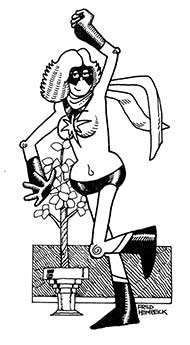
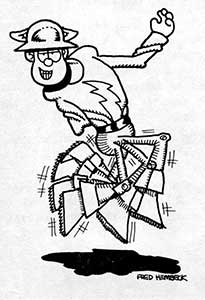 Willie Peppers really embodies the fan ethic that was prevalent in those days…work hard, love what you do, and, in Willie’s case, turn out a darn high volume of that work you love! Thanks for all that enthusiasm, Willie!
Willie Peppers really embodies the fan ethic that was prevalent in those days…work hard, love what you do, and, in Willie’s case, turn out a darn high volume of that work you love! Thanks for all that enthusiasm, Willie!
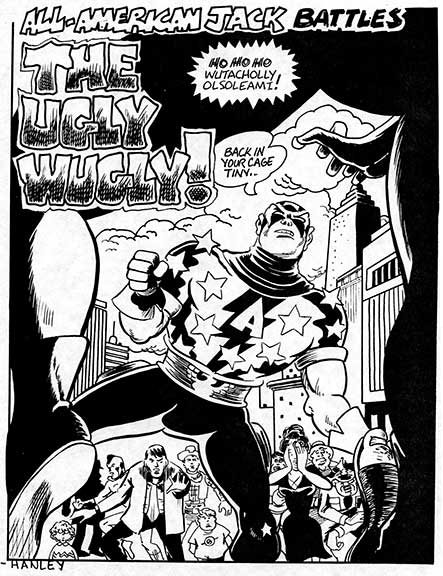


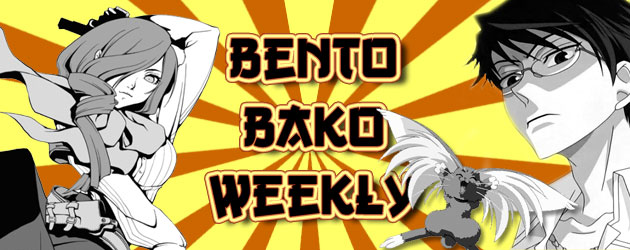
Great interview, Ken! I love hearing from old school guys, because they have a certain perspective that isn’t seen anymore. Kudos!
You are so right, Billy, glad you liked it!
Excellent presentation as usual; a goldmine for bronze and silver age fans.
I never had a copy of this one — probably because 1978 was the year I joined the USAF. This is a nice little ‘zine — with some of Hanley’s All-American Jack inside, to boot!